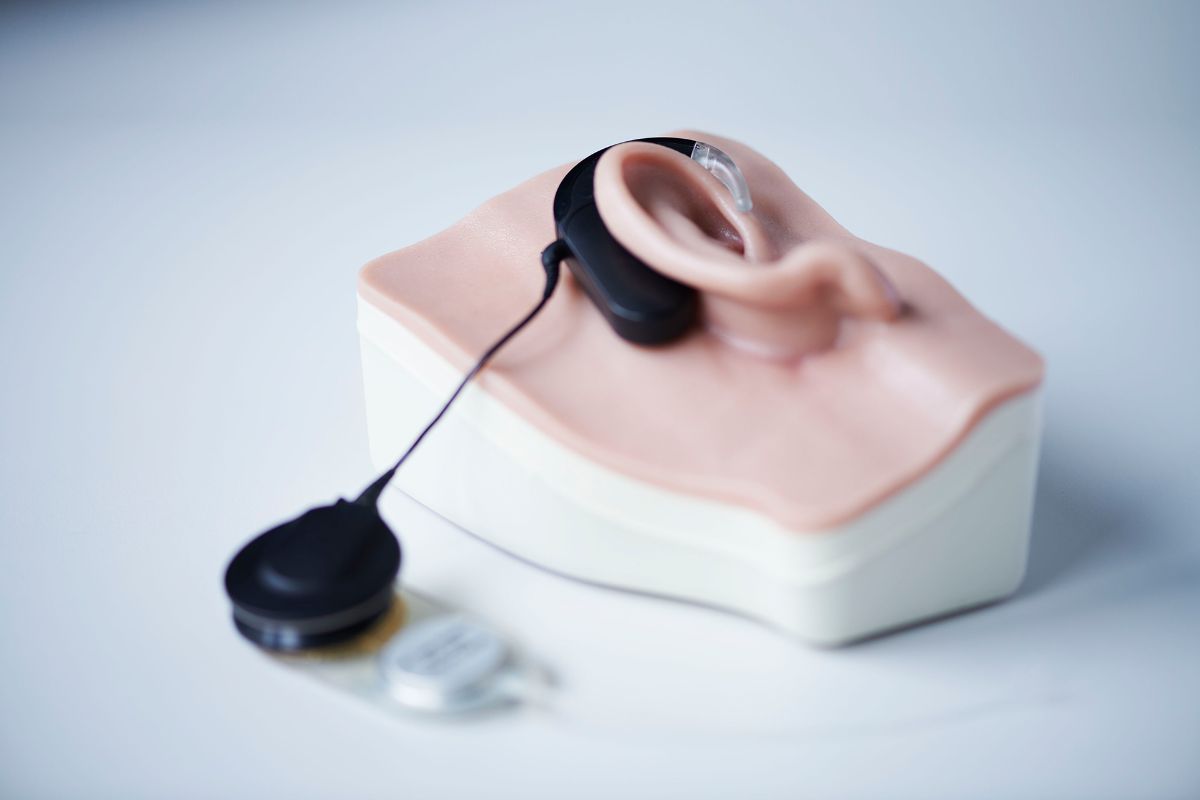
CI Center
People with very severe hearing problems cannot fall back on a conventional hearing aid. So-called cochlear implants can help these people.
What is a CI?
A cochlear implant is a hearing prosthesis consisting of two components. One component is the receiver block with one or two electrode strands which are worn intracorporeally, the actual implant. The extracorporeal system component is the speech processor, consisting of a microphone, processor and transmitter coil. Today, this component is not significantly larger than a conventional hearing aid. A CI electronically replaces the natural stimulus transmission of the sensory cells on the auditory nerves, which previously failed in the inner ear (cochlea).
You can find more information on this topic at
- Operation or
- Requirements
on this website.
The microphone (1) picks up the sound from the surroundings and transmits this signal to the speech processor (2).
The signal is processed and encoded in the speech processor. It is forwarded to the externally worn transmitter coil (4) via a short cable (3).
The signal is then transmitted to the implant (5) via radio waves through the scalp.
The implant receives the signal and is supplied with power. This means that no additional power source is required for the implant.
The corresponding electrodes (6) in the cochlea are stimulated according to the pitch and volume of the received signal.
The auditory information is transmitted to the brain via the auditory nerve (7).
Prerequisites
Today, modern hearing aid acoustics are able to provide almost every hearing-impaired person with adequate hearing aids. A hearing aid in the form of a hearing aid is always the best solution for mild to severe sensorineural hearing loss. Hearing aids always utilize the natural functions of the inner ear despite the disease of the hearing organ, which enables relatively natural hearing despite the required amplification. However, if hearing loss is so advanced that even a very powerful hearing aid is no longer of any use, a cochlear implant (CI) can be used. The same naturally also applies to patients who suddenly go deaf (e.g. as a result of an accident) or were even born deaf. In Western Europe, on average one in 1000 newborns is born deaf.
If the ear, nose and throat (ENT) doctor diagnoses a hearing impairment bordering on deafness, the patient is usually referred to an ENT clinic with CI experience. During the assessment phase, a series of tests are carried out to confirm the hearing loss and to determine whether CI surgery will have the desired effect. In any case, an attempt is made to record a sound audiogram (if measurable). An attempt is made to determine the patient's individual hearing threshold.
This is followed by examinations such as the measurement of acoustic evoking potentials (ERA/AEP). Electrodes attached to the scalp are used to examine whether a sound is processed by the brain. A promontory test can also be carried out on adults. This examines whether the auditory nerve can be electrically stimulated. Imaging procedures are important for the surgeon to get an idea of the patient's anatomy. A computer tomogram (CT) and a magnetic resonance image (MRI) of the head area are created, which show the bones and soft tissues in three dimensions. An important part of the assessment procedure is the consultation, in which the functionality of the CI is explained to patients and their relatives. In addition, the goals, limitations and expectations of the CI are discussed with all those affected. If there are no objections from the doctors, technicians, teachers and, above all, the patient, an application for cochlear implantation is submitted to the IV and the health insurance company.
The operation
CI surgery is performed at the ENT Clinic of the University Hospital Basel. Children under the age of 16 are hospitalized and operated on in the neighbouring University Children's Hospital Basel (UKBB), as a special paediatric anaesthetic is required. The patients are called up the day before the operation. This is used for final pre-operative examinations and for preliminary discussions between the anesthetist and the patient or parents.
A CI operation usually takes 1-2 hours and is performed under general anesthesia under constant observation by an anesthesiologist.
First, a small incision is made behind the ear to be operated on and folded away so that the skull bone can be exposed. Beforehand, the patient's hair is partially shaved at this point of the skull. The surgeon then creates a canal into the tympanic cavity to gain access to the cochlea (inner ear) via the middle ear. A bed is then milled in the skull bone where the CI's receiver coil will later be located. The receiver block of the implant (which makes up the largest part) is fixed in the bone bed. During the operation, the technical staff check the technical integrity of the CI system.
The adjustment
5-6 weeks after the cochlear implant operation (see the operation), the implant is activated for the first time. This period is necessary to allow the swelling caused by the operation to heal completely. An implant test (impedance telemetry) is always carried out with every CI fitting. Here, each individual electrode is controlled.
The feedback from the electrodes provides information about the condition and functionality of the implant. The actual activation of the implant then begins. The auditory nerve is stimulated using very weak current stimuli.
The patient is offered current pulses of different intensities. The patient must try to assign these different auditory impressions to a scale. Based on this information, the range can be determined and assigned. These measurements are also carried out for each individual electrode. Special "listening games" have been developed for children. They are used in an age-specific manner and provide important information on hearing perception through the course of the game. Initially, the patient may find it difficult to provide precise information about the auditory impressions gained. The incoming impulses sound unfamiliar. It takes some time for the hearing to adjust to this new sound processing. Regular adjustment is therefore important, especially at the beginning.
Modern CIs
The Ci - Klinikzentrum Basel works hand in hand with the three largest CI manufacturers in the world. These are the companies Cochlear AG, Med El and Advanced Bionics. Their implants, as well as the associated external components, are presented on the corresponding links. Simply follow a link to the three manufacturers of your choice:

Logos of offered CI systems
MRI safety instructions
Under certain conditions, cochlear implants (CI) can be compatible, conditionally compatible or incompatible in relation to MRI imaging procedures. This depends on the one hand on the CI manufacturer and implant type, and on the other hand on the respective country-specific regulations.
In order to obtain the necessary information, you will need the exact implant type identifier in addition to the manufacturer. This can be obtained from the patient's implant passport or from the ENT clinic responsible.
With this information, you can call up all the information you need on the relevant CI manufacturer's website. We have listed the relevant links below
Links
University Hospitals Basel
CI manufacturer
CI Centers in Switzerland
Schools
Associations and institutions
Follow the link to get to the section of the website that deals with questions and answers about the CI. In the section for CI users, important questions for patients who have already been implanted are discussed. The CI general section answers questions that frequently arise in the run-up to CI treatment.

Pediatric otorhinolaryngology (ORL), i.e. ear, nose and throat diseases in children, is increasingly viewed internationally as an independent sub-discipline of ENT.
In close cooperation with the University Children's Hospital of Basel, we treat all children with a wide variety of ear, throat and nasal diseases.

